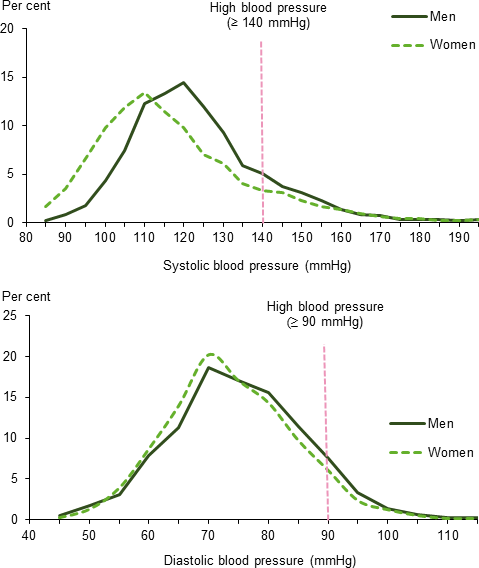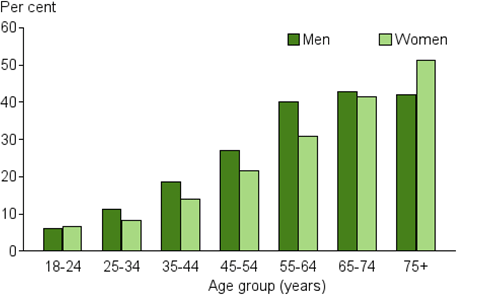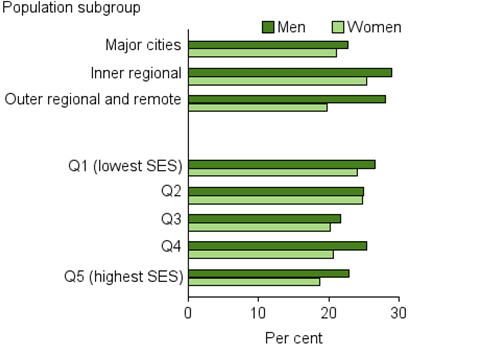High blood pressure
High blood pressure—also known as hypertension—is a major risk factor for chronic diseases including stroke, coronary heart disease, heart failure and chronic kidney disease. High blood pressure is also a cardiovascular disease in its own right. The risk factors for high blood pressure include poor diet (particularly a high salt intake), obesity, excessive alcohol consumption and insufficient physical activity. High blood pressure can be controlled with lifestyle measures and medication to reduce the risk of chronic disease.
Box 1: How is high blood pressure measured?
Blood pressure is the force exerted by the blood on the walls of the arteries and is written as systolic/diastolic (e.g. 120/80 mmHg, stated as '120 over 80').
The World Health Organization defines high blood pressure as including any of the following [1]:
- systolic blood pressure greater than or equal to 140 mmHg, or
- diastolic blood pressure greater than or equal to 90 mmHg, or
- receiving medication for high blood pressure.
The Australian Bureau of Statistics (ABS) 2011–12 Australian Health Survey (AHS) measured blood pressure at the time of the interview, and the definitions listed above were used in defining high blood pressure in the results presented here. 'Uncontrolled high blood pressure' is defined as measured systolic blood pressure of 140 mmHg or more, or diastolic blood pressure of 90 mmHg or more, irrespective of the use of blood pressure medication [2].
Who has high blood pressure?
Based on measured data from the 2014–15 AHS, about 1 in 3 people aged 18 and over (34%) have high blood pressure. This is comprised of:
- 23% with uncontrolled high blood pressure
- 11% whose blood pressure was controlled using medication/s.
The average systolic blood pressure is higher for men (126 mmHg) than for women (120 mmHg). The average diastolic blood pressures are similar for men and women (77 and 76 mmHg) (Figure 1).
Over three-quarters (79%) of those with high blood pressure were overweight or obese, and 42% reported doing very little or no exercise in the past week [3].
Figure 1: Blood pressure, persons aged 18 and over, by sex, 2014–15

Note: Excludes persons for whom blood pressure was not measured or a valid reading was not obtained.
Source: AIHW analysis of ABS Microdata: National Health Survey, 2014–15.
In 2014–15, a higher proportion of men (24%) than women (22%) had uncontrolled high blood pressure (Figure 2). The proportion of adults with uncontrolled high blood pressure increased with age―from less than 10% among 18–24 year-olds (6.0% for men and 6.7% for women) to a peak of 53% at age 85 and over (49% for men and 54% for women).
Figure 2: Prevalence of uncontrolled high blood pressure in persons aged 18 and over, by sex, 2014–15

Note: Excludes persons for whom blood pressure was not measured or a valid reading was not obtained.
Source: AIHW analysis of ABS Microdata: National Health Survey, 2014–15 (see source data).
Inequalities
Uncontrolled high blood pressure is most prevalent in the population living in Inner regional areas (29% of men and 25% of women) and is more common in areas of most disadvantage. Twenty six per cent of people living in the most disadvantaged areas have high blood pressure, compared with 21% of people living in the least disadvantaged areas.
Figure 3: Prevalence of uncontrolled high blood pressure in persons aged 18 and over, by sex, by selected population characteristics, 2014–15

Notes:
- Excludes persons for whom blood pressure was not measured or a valid reading was not obtained.
- Q1–Q5 refers to area-based quintiles of socioeconomic position, based on the ABS Index of Relative Socio-Economic Disadvantage (IRSD) [4].
Source: AIHW analysis of ABS Microdata: National Health Survey, 2014–15 (see source data).
International comparisons
The World Health Organization reported that an estimated 21% of men and 17% of women aged 18 and over in Australia had uncontrolled high blood pressure in 2015 (based on systolic blood pressure and diastolic blood pressure only) [5]. This was a lower proportion than most other OECD countries (Organisation for Economic Cooperation and Development), and lower than the average across the 34 OECD countries (24% for men and 21% for women).
United Arab Emirates had the lowest proportion (15% for men and 8.7% for women), followed by Peru (15% for men and 10% for women) and Korea (15% for men and 11% for women), while central and eastern European countries including Bulgaria, Latvia, Hungary, Slovenia and Croatia had the highest (all above 39% for men and 33% for women).
Source data
References
- Whitworth JA 2003. 2003 World Health Organization/International Society of Hypertension statement on management of hypertension. Journal of Hypertension 21:1983-92.
- ABS (Australian Bureau of Statistics). Australian Health Survey: users' guide, 2011–13. ABS cat. no. 4363.0.55.001. Canberra: Australian Bureau of Statistics.
- ABS 2017. Health Service Usage and Health Related Actions, Australia 2014–15: Hypertension. ABS cat no. 4364.0.55.002. Canberra: Australian Bureau of Statistics. Viewed 7 April 2017.
- ABS 2013. Census of Population and Housing: Socio-Economic Indexes for Areas (SEIFA). ABS cat. no. 2033.0.55.001. Canberra: Australian Bureau of Statistics.
- WHO (World Health Organization) 2015. WHO global health observatory data repository. Raised blood pressure (SBP ≥ 140 OR DBP ≥ 90). Date by country. Geneva: World Health Organization. Viewed 4 April 2017.


